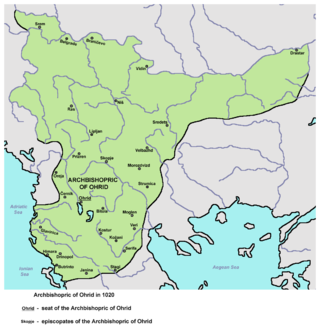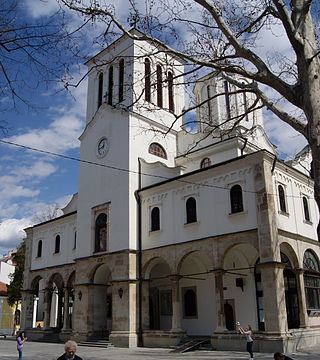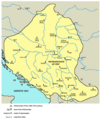
The Serbian Orthodox Church is one of the autocephalous Eastern Orthodox Christian churches.

The Archbishopric of Ohrid, also known as the Bulgarian Archbishopric of Ohrid, originally called Archbishopric of Justiniana Prima and all Bulgaria, was an autocephalous Eastern Orthodox Church established following the Byzantine conquest of Bulgaria in 1018 by lowering the rank of the autocephalous Bulgarian Patriarchate due to its subjugation to the Byzantines. In 1767, the Archbishopric's autocephaly was abolished, and the Archbishopric was placed under the tutelage of the Patriarchate of Constantinople.

The Patriarchate of Peć Monastery or the Patriarchal Monastery of Peć, is a medieval Serbian Orthodox monastery located near the city of Peja, Kosovo. Built in the 13th century, it became the residence of Serbian Archbishops. It was expanded during the 14th century, and in 1346, when the Serbian Patriarchate of Peć was created, the Monastery became the seat of Serbian Patriarchs. The monastery complex consists of several churches, and during medieval and early modern times it was also used as mausoleum of Serbian archbishops and patriarchs. Since 2006, it is part of the "Medieval Monuments in Kosovo", a combined World Heritage Site along with three other monuments of the Serbian Orthodox Church.

The Eparchy of Banat is an ecclesiastical territory or eparchy of the Serbian Orthodox Church in the Banat region, Serbia. It is mostly situated in the autonomous province of Vojvodina, while the eparchy also includes a small south-western part of Banat that belongs to the City of Belgrade as well as village of Ostrovo that belongs to the city of Požarevac. The seat of the eparchy is in Vršac.

The Metropolitanate of Karlovci was a metropolitanate of the Eastern Orthodox Church that existed in the Habsburg monarchy between 1708 and 1848. Between 1708 and 1713, it was known as the Metropolitanate of Krušedol, and between 1713 and 1848, as the Metropolitanate of Karlovci. In 1848, it was elevated to the Patriarchate of Karlovci, which existed until 1920, when it was merged with the Metropolitanate of Belgrade and other Eastern Orthodox jurisdictions in the newly established Kingdom of Serbs, Croats and Slovenes to form the Serbian Orthodox Church.

Eparchy of Raška and Prizren is one of the oldest eparchies of the Serbian Orthodox Church, featuring the seat of the Serbian Orthodox Church, the Serbian Patriarchal Monastery of Peć, as well as Serbian Orthodox Monastery of Visoki Dečani, which together are part of the UNESCO World Heritage sites of Serbia. More than 100 of the Eparchy's churches and monasteries were targeted for vandalism and destruction by Albanian nationalists after the Kosovo War and during the 2004 unrest in Kosovo.

Christianity is the predominant religion in Serbia. The Constitution of Serbia defines it as a secular state with guaranteed religious freedom. Eastern Orthodox Christians with 6,079,396 members, comprise 84.5% of country's population. The Serbian Orthodox Church is the largest and traditional church of the country; adherents of it are overwhelmingly Serbs. Public schools in Serbia allow religious teaching, most commonly with the Serbian Orthodox Church. Serbian public holidays include the religious celebrations of Eastern Orthodox Christians. Other Orthodox Christian communities in Serbia include Montenegrins, Romanians, Macedonians, and Bulgarians. The Catholic Church is prominent in north Vojvodina amongst the Hungarian minority. Protestantism is most largely found in Slovak populations within Bački Petrovac and Kovačica. Christianity first arrived in Serbia in the 9th century. It became state-religion in the 9th century when Serbia began to identify as a Christian country. In a 2011 census, 91.22% of Serbians identified as Christian.

Archbishopric of Belgrade and Karlovci is the central or patriarchal eparchy of the Serbian Orthodox Church, with seat in Belgrade, Serbia. The head of the eparchy is the Serbian patriarch.
The Archdiocese or Archbishopric of Arad, formerly the Bishopric of Arad is an episcopal see of the Romanian Orthodox Church, under the administration of the Metropolis of Banat, with jurisdiction over Arad County in Romania. The current head is bishop Timotei Seviciu.
This is a list of historical administrative divisions of Serbia since the establishment of the Principality of Serbia until today.

Eparchy of Lipljan, later known as the Eparchy of Gračanica or the Eparchy of Novo Brdo is one of the former historical Eastern Orthodox eparchies of Serbian Orthodox located in the central parts of Kosovo region.. It is now part of Eparchy of Raška and Prizren. In older research, it was mistakenly identified as the bishopric of Ulpiana.
Serbian Patriarchate may refer to:

The Serbian Patriarchate of Peć or just Patriarchate of Peć, was an autocephalous Eastern Orthodox Patriarchate that existed from 1346 to 1463, and then again from 1557 to 1766 with its seat in the Patriarchal Monastery of Peć. It had ecclesiastical jurisdiction over Eastern Orthodox Christians in Serbian Lands and other western regions of Southeastern Europe. Primates of the Patriarchate were styled Archbishop of Peć and Serbian Patriarch.

Eparchy of Polog and Kumanovo was an Eastern Orthodox Eparchy of the Orthodox Ohrid Archbishopric, an autonomous and canonical branch of the Serbian Orthodox Church in North Macedonia. Its seat is in Kumanovo. During all of its existence, the Bishop of Polog and Kumanovo was Joakim Jovčevski. It was established in 2003 when the Orthodox Ohrid Archbishopric was formed as part of the Serbian Church. It was abolished in 2023 and merged into the Macedonian Orthodox Church.

The Eparchy of Niš is an eparchy (diocese) of the Serbian Orthodox Church with its seat in Niš, in Serbia. It has jurisdiction over the south-eastern regions of Serbia. Since 2017, Serbian Orthodox Bishop of Niš is Arsenije Glavčić.

The Metropolitanate of Skopje is an Eastern Orthodox eparchy, formerly under the jurisdiction of the Orthodox Ohrid Archbishopric, an autonomous and canonical branch of the Serbian Orthodox Church in North Macedonia. Its seat is in Skopje. It is a metropolitan diocese of the Orthodox Ohrid Archbishopric, headed by Archbishop Jovan Vraniškovski of Ohrid, who is also styled Metropolitan of Skopje.

Eparchy of Debar and Kičevo was an Eastern Orthodox eparchy (diocese) of the Orthodox Ohrid Archbishopric, an autonomous and canonical branch of the Serbian Orthodox Church in North Macedonia. Its historical seat is in the city of Debar. During its existence, the eparchy was under administration of Bishop Joakim Jovčevski of Polog and Kumanovo.



















